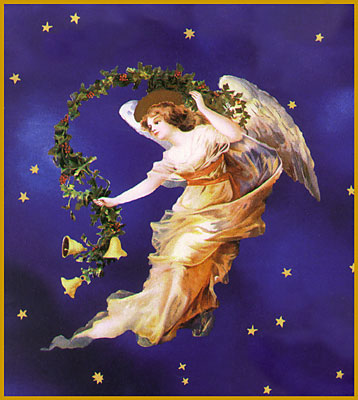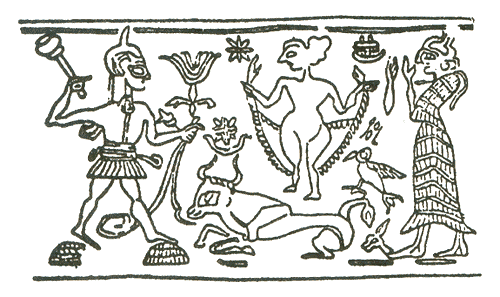Did You Know... there are many Christmas symbols that are full of biblical meaning and Christian history? Below are a few of those symbols that are often depicted in images of Christmas:
~ Angels
 The term [angel] literally means “messenger,” and it is in this distinguished role that heavenly angels take part in the Christmas story. An angel appeared to Mary to announce the birth of Christ (Luke 1:26-38). An angel came to Joseph telling him that what was conceived in Mary was from the Holy Spirit (Matthew 1:20-21). And, an angel appeared to shepherds to announce the birth of Jesus after which “a great company of the heavenly host” appeared (Luke 2:8-14). While angels are mentioned throughout the Bible, those present at the birth of Christ are the most well known in biblical literature.
The term [angel] literally means “messenger,” and it is in this distinguished role that heavenly angels take part in the Christmas story. An angel appeared to Mary to announce the birth of Christ (Luke 1:26-38). An angel came to Joseph telling him that what was conceived in Mary was from the Holy Spirit (Matthew 1:20-21). And, an angel appeared to shepherds to announce the birth of Jesus after which “a great company of the heavenly host” appeared (Luke 2:8-14). While angels are mentioned throughout the Bible, those present at the birth of Christ are the most well known in biblical literature.
For more information, please visit the following page: Angels
~ Bells
 Though bells were used during the time of antiquity - and even in the Jewish temple (on the hem of priestly garments) - their association with the Christian Church may well have come from an unlikely source... St. Patrick. The famous bell of St. Patrick resides in Ireland, and according to tradition, Patrick, a missionary to the Emerald Island in the 5th century, used it to gather the Irish people together for the teaching and preaching of God’s Word. With time, the bell came to be associated with the Lord’s work and to symbolize something sacred... hence the ringing of bells at Christmas.
Though bells were used during the time of antiquity - and even in the Jewish temple (on the hem of priestly garments) - their association with the Christian Church may well have come from an unlikely source... St. Patrick. The famous bell of St. Patrick resides in Ireland, and according to tradition, Patrick, a missionary to the Emerald Island in the 5th century, used it to gather the Irish people together for the teaching and preaching of God’s Word. With time, the bell came to be associated with the Lord’s work and to symbolize something sacred... hence the ringing of bells at Christmas.
~ Candy Canes
For more information, please visit the following page: Candy Canes
~ Christmas Trees
For more information, please visit the following page: Christmas Trees
~ Gifts
The Bible teaches, "Every good and perfect gift is from above, coming down from the Father". The practice of giving gifts in America is rooted in the European celebration of St. Nicholas' Day on December 6th. St. Nicholas served as the Archbishop of Myra in the 4th century. It was not until after his death that stories of his generosity spread throughout Europe.
By the 12th century, people were giving gifts in his name [St. Nicholas]. However, in America, the tradition was transferred to coincide with Christmas. Since Christmas was the celebration of the birth of Christ (God's gift to the world) and the Wise Men set a biblical precedent of giving during the season, this transfer was quite natural. St. Nicholas, who later became known as Santa Claus, is said to have set an example of biblical giving by secretly giving to those in need.
For more information, please visit the following page: Gifts
For more information, please visit the following page: Gifts
| ~ Holly |
For more information, please visit the following page: Holly
~ Wise Men
 While the number of Wise Men who made the trip to Bethlehem is not known (the Bible does not give an exact count), Western tradition claims there were three. This is most likely rooted in the fact that they [the Wise Men] delivered three gifts to the baby child known as Jesus. Those gifts included gold, frankincense and myrrh. Eastern tradition holds that there were 12 Wise Men. In early drawings of the Nativity, found in Roman catacombs, some show two Magi (or Wise Men), while another shows four. Yet, the fact remains that Wise Men did make a journey to Bethlehem with gifts for the Messiah. Christians have associated the Wise Men with Christmas since the birth of Christ.
While the number of Wise Men who made the trip to Bethlehem is not known (the Bible does not give an exact count), Western tradition claims there were three. This is most likely rooted in the fact that they [the Wise Men] delivered three gifts to the baby child known as Jesus. Those gifts included gold, frankincense and myrrh. Eastern tradition holds that there were 12 Wise Men. In early drawings of the Nativity, found in Roman catacombs, some show two Magi (or Wise Men), while another shows four. Yet, the fact remains that Wise Men did make a journey to Bethlehem with gifts for the Messiah. Christians have associated the Wise Men with Christmas since the birth of Christ.For more information, please visit the following page: Wise Men
~ ~ ~ ~ ~ ~ ~ ~ ~ ~ ~ ~ ~ ~ ~ ~ ~
Over the years, many of these symbols have lost their Christian symbolism in a secular world, but regardless of such a station, Christmas symbols are still replete with an abundance of indication.






